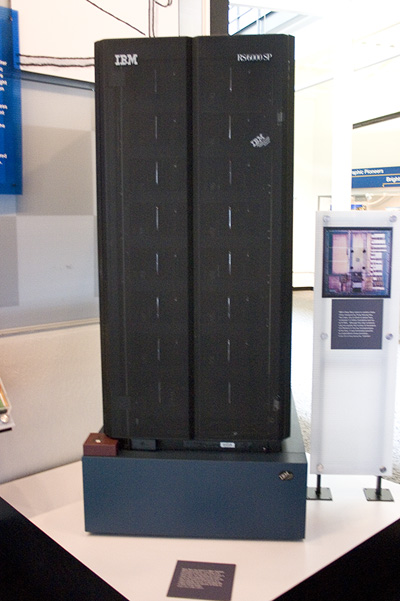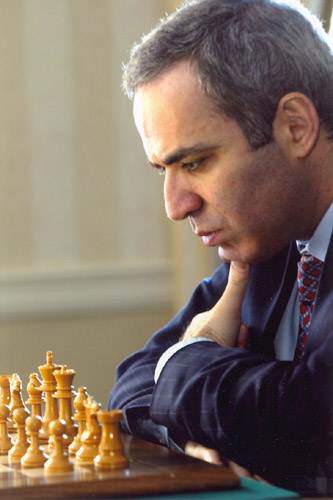
On this day 10 years ago, the human race got an inferiority complex. A computer, Deep Blue, beat Russian Garry Kasparov, the greatest chess player on the planet, and mankind’s place in the order of things was reshuffled.
Blame IBM. Deep Blue was just the latest in a line of three supercomputers developed by Big Blue’s research scientists over the decade before its triumph in New York on May 11, 1997.
The first, Deep Thought, emerged in 1988 from the drawing board of Carnegie Mellon grad student Feng-hsiung Hsu, who was hired by the computer maker a year later with the express intention of usurping the primacy of human logic.

Deep Blue, a computer similar to this one defeated chess world champion Garry Kasparov in May 1997. It is the first computer to win a match against a world champion. Photo taken at the Computer History Museum. Photo: James the photographer, CC-BY.
Upon joining IBM, Hsu recruited several programmers, including his computer science classmate, Canadian Murray Campbell, with whom he had prototyped an early chess-playing computer named Chiptest several years earlier.
Kasparov, who was the youngest-ever world chess champion, trounced the first Deep Thought in a 1989 matchup. A much-improved machine, benefiting from IBM’s considerable resources, proved stiffer competition in a February 1996 rematch. It was the third incarnation, dubbed Deep Blue, that finally knocked the master from his perch 15 months later.

De Garri Kasparow géint de Computerprogramm Deep Junior am Januar 2003. Copyright 2007, S.M.S.I., Inc. – Owen Williams, The Kasparov Agency.
The match immediately became an iconic symbol of the advances made in artificial intelligence and supercomputing. Kasparov has since retired, like Deep Blue, which now resides in a museum. He has become a vocal advocate for democracy in today’s Russia. But Campbell, who moved the pieces on Deep Blue’s command, is still at IBM in New York state; he told Wired News he would mark the anniversary by watching videos of the contest.
Wired News: What is the state of supercomputer-versus-human matchups? How are we humans doing?
Murray Campbell: Not so well! The current world champion, Vladimir Kramnik from Russia, lost a match to a PC program in November, 4-2. If you look at the supercomputer that Deep Blue ran on, I think a present-day Cell processor has as much processing power as that entire system did in 1997.
WN: What’s going to be the next move in supercomputing over the next 10 years?
Campbell: It’s almost the end of the story for chess in the sense that matches between chess machines and grand masters are becoming less interesting because it’s so difficult for the human grand masters to compete successfully.
They’re even taking relatively dramatic steps like giving handicaps to computers, making them play the game with a pawn less or playing the game with less time. We’re past the stage where there’s a debate about who’s better — machines or grand masters — and we’re just looking for interesting ways to make the competition fairer.
WN: So we can live in harmony?
Campbell: Absolutely. Very nicely.
WN: Why do you think the match captured the public imagination to such a great degree?
Campbell: Not everybody plays but everybody knows that chess is a very difficult game — you can devote your whole life to playing chess and still have room for improvement. So it’s understood that chess is a game which requires intelligence and so for a machine to play at the level of the world champion is a sign that computers have progressed further than maybe some people had thought they had. In one sense, it’s just one milestone among many along the way, but it’s one that the general public could understand more easily.
WN: Some conspiracies emerged that say the computer was being controlled by human grand masters behind the scenes. Your response?
Campbell: In my mind, they’re ridiculous. One of the things about conspiracy theories is that, really, you should present some evidence rather than just make a theory up. In the 10 years since the match, I have yet to see any evidence of cheating.
WN: What are Deep Blue’s roots, and on what technological principles did its forebears operate?
Campbell: Claude Shannon, the famous computer scientist and mathematician proposed that chess was a grand challenge for these new things called computers — if you could get a computer to play chess at the world champion level, you had done something really special.
There was a turning point in the ’70s when it was realized that, if you let computers do what they do best — that is, search through as many possibilities as they can as quickly as they can — and stop the pretense of trying to emulate how humans play, you actually got better performance.
And so, from that day on, computers, including Deep Blue, tended to be focused on searching through as many possible chess moves as they could in the amount of time that was available for a computation.
WN: How did the notion come about of a contest with Kasparov? It was obviously going to be a high-profile match.
Campbell: I don’t think it was obvious at all. Actually, at the time, in 1989, it was a fairly low-key event. There were just two games between Deep Thought and Kasparov and I think many people were surprised at the level of interest that that match drew.
WN: Kasparov easily beat Deep Thought 2-0. Was the machine a sore loser?
Campbell: No, it took it pretty well.
WN: The buildup to the first Deep Blue game — were you guys at all nervous?
Campbell: Yeah, it was a bit of a nerve-wracking time, mainly because the hardware that Deep Blue ran only got working a few weeks before the match. So there was frantic testing before the first match. Pretty much it was right down to the wire, so we obviously were quite pleased when it won the first game of that match, even though it lost the match.
WN: Deep Blue got some software modifications and hardware upgrades for its next match that helped it analyze 200,000,000 moves per second. That’s some halftime pep talk.
Campbell: That was one of the factors we ran on a larger IBM supercomputer, but we also redesigned the chess-specific hardware so it would run more chess patterns. It just understood more about chess and was able to play better because of it. We told it what it was doing wrong, in a sense, and hoped that would be fixed.
WN: You took input from several chess experts in developing Deep Blue. Do you think that put the machine at an unfair advantage over Kasparov?
Campbell: No. We obviously were going to improve the system and work with grand masters to help us do that. Kasparov, of course, had a team of assistants to help him as well.
WN: By 1997, the machine actually played in a way that was quite human, even making a mistake at one point, while Kasparov was forced to change his usually liberal game for a more robotic style. What on earth was going on?
Campbell: Conventional wisdom then, and even now, is that you don’t want to go into complications against a strong chess computer because you will lose — you’ll get out-calculated. And so this was Kasparov’s attempt to keep the game more strategic, more under control.
WN: What did it feel like to win finally?
Campbell: It was obviously a highlight of my career. I was a chess player growing up and so to be sitting across the chess board from Kasparov was a thrill in itself.
WN: Kasparov’s request for a rematch was turned down. Why do you think that was? It looked like IBM had got good publicity but took the ball away and didn’t want to play anymore.
Campbell: I believe we had accomplished what we were trying to do for so many years and it was time to move on to other problems. Garry Kasparov has now retired from chess and Deep Blue is in a museum so that’s not going to happen, but matches between other computers and the current world champion have taken place as recently as last year.
WN: What did the contest do for IBM and you personally?
Campbell: IBM was an also-ran in supercomputing, it was not one of the top two in the field. Nowadays, IBM has nearly half of the top 500 supercomputers in the world, it dominates this market now and it certainly has the fastest supercomputer in the world as well.
Campbell: For me personally, I’ve had a chance over the years since then to become more of a user of supercomputers than a designer of supercomputers. I’ve done a lot of work in data analysis projects in financial and public health and the petroleum industry so I’ve come to appreciate the things that supercomputers can do in solving complex problems in these industries.